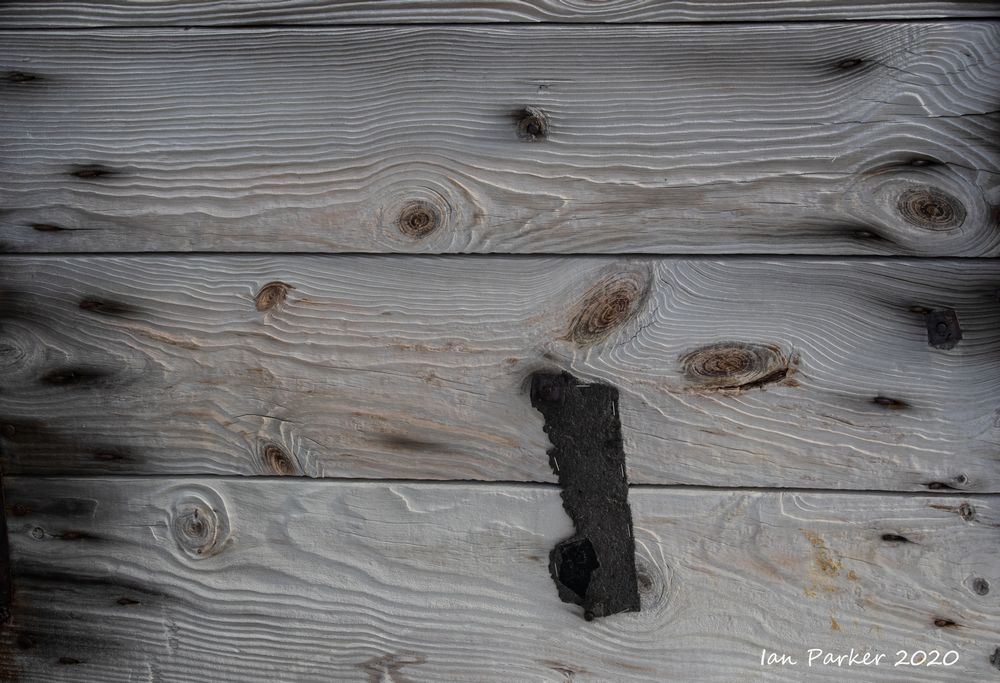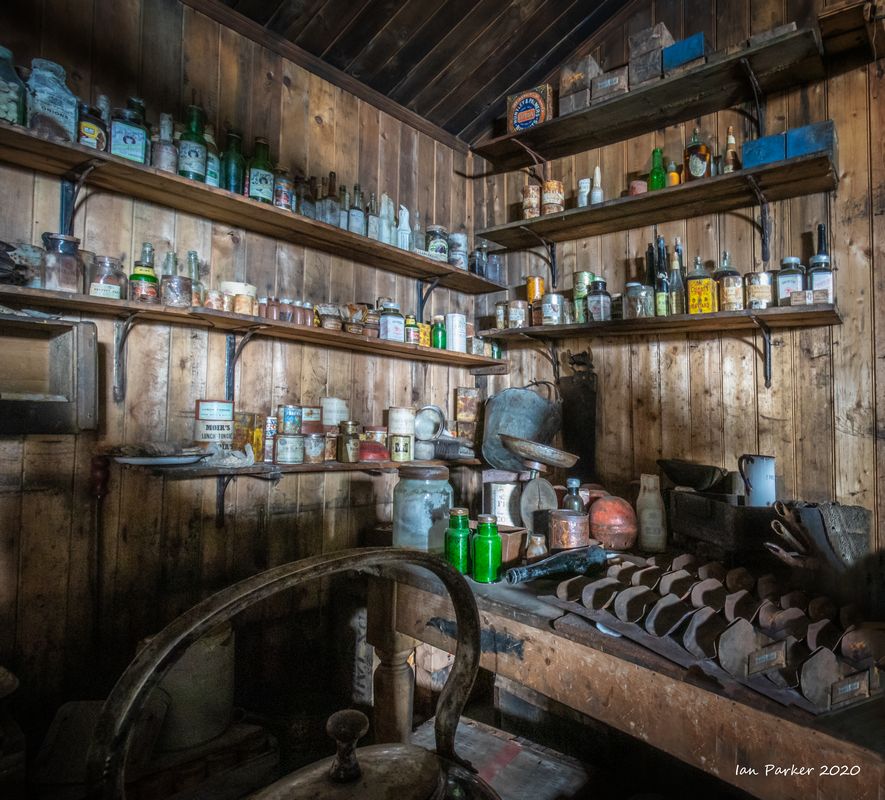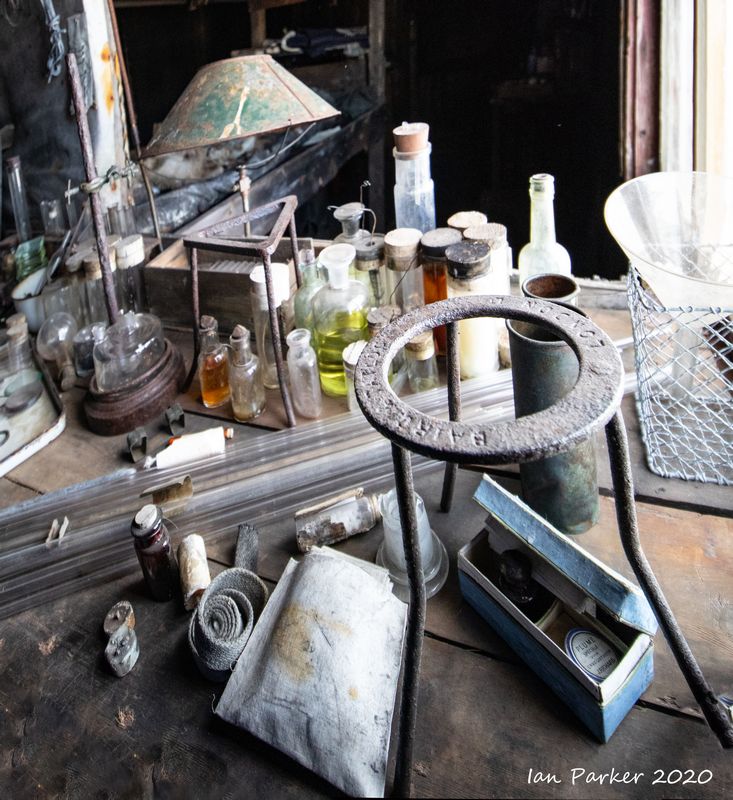Historic Antarctic Huts from the Heroic Age of polar exploration |
Photos are from a visit to Ross Island and Cape Adare in 2020, aboard the Spirit of Enderby, on a trip with Heritage Expeditions.
Green line shows the path we took after leaving McMurdo Station (#3). Grey areas on the satellite photo are sea ice, which had melted and broken up at the time of our visit. |
|
|
Scott's hut at Cape Evans
|
Scott’s hut at Cape Evans is the iconic base associated with Captain Robert Falcon Scott’s British Antarctic (Terra Nova) Expedition 1910–1913 and his second, and final, famed attempt for the Geographic South Pole. The expedition had two aims: to continue scientific research and secure the South Pole for the British Empire. In early January 1911, after stopping to resupply in New Zealand, the Terra Nova anchored at Cape Evans and the base was quickly established. On 1 November 1911 Captain Scott and his men set out to reach the South Pole. All members of the polar party perished on their return journey. This expedition gave rise to some of the most inspirational and harrowing stories associated with polar history. It was also instrumental in laying the foundations of modern science in Antarctica.
Scott’s hut at Cape Evans is the largest of the historic huts in the Ross Sea region. Prefabricated in London, a trial erection took place in Lyttelton, New Zealand before being shipped to Antarctica. Construction took nine days, and the hut was home to 25 members of Scott’s Shore Party.
Scott described the hut’s feeling of comfort: “The word hut is misleading. Our residence is really a house of considerable size, in every respect the finest that has ever been erected in the polar regions; 50ft long by 25 wide and 9ft to the eaves.”
When the remaining members of Scott’s second expedition left Cape Evans in January 1913 the hut stood empty before being visited and later inhabited by Shackleton’s Ross Sea Party (1914-1917). |
|
|
|

Wind-scoured wood; Scott's hut at Cape Evans |

Interior corner with handle of kettle; Scott's hut at Cape Evans |
|
|

Chemical analysis; Scott's hut at Cape Evans |
|
|
Scott's Discovery hut at Hut Point
This is the base associated with Commander Robert Falcon Scott’s National Antarctic (Discovery) Expedition 1901–1904. The expedition included a major programme of science and was a landmark in British Antarctic exploration, resulting in Scott returning to Britain as a hero. His base became an important staging post for every subsequent heroic-era expedition.
Robert Falcon Scott’s National Antarctic Expedition 1901–04, a joint initiative between The Royal Geographical Society and The Royal Society, was the second expedition to winter over on the Antarctic continent, and the first to carry out significant exploration and serious scientific research. Three of the most famous men in Antarctic exploration – Scott, Shackleton and Wilson – achieved a furthest south sledging journey of 82º 16’ S in the summer of 1902–03.
Scott’s Discovery Hut is a framed and panelled structure, prefabricated and made of Douglas fir and Scots pine. Prefabricated in Sydney, the hut is square, its Australian origins evident in the open verandah that surrounds three sides.
The hut proved too hard to heat and was described as being more like a summer house. Consequently, it was never used as a base and the 47 men lived on their ship, using the hut for scientific observations, drying equipment, repairs and as an entertainment house.
The expedition base at Hut Point was later used by three other heroic-era expeditions, all of which left their mark on the hut and its contents. Today, Scott’s first expedition base at Hut Point remains a testament not only to scientific endeavour but also to the hardships endured by its later occupants, particularly Shackleton’s Ross Sea Party. |
|
 |
A more extensive history of the hut, abstracted from Wikipedia
Visitors to Antarctica, arriving at either the US Base at McMurdo or New Zealand's Scott Base are likely to encounter Discovery Hut as both are located on Hut Point. Discovery Hut is just 300m from McMurdo Base. The hut has been designated a Historic Site or Monument (HSM 18), following a proposal by New Zealand and the United Kingdom to the Antarctic Treaty Consultative Meeting.
British National Antarctic Expedition 1901-1904
The Discovery hut was a large strong building, but was so draughty and cold in comparison with the ship, which was moored one hundred yards away, that it was, during the first year, never used for living quarters. Its sole use was as a storehouse, and a large supply of rough stores, such as flour, cocoa, coffee, biscuit, and tinned meat, was left there in the event of its being used as a place of retreat should any disaster overtake the ship. During the second year occasional parties camped inside the hut, but no bunks or permanent sleeping quarters were ever erected. When the Discovery finally left McMurdo Sound, the hut was stripped of all gear, including the stove, but there was left behind a large depot of stores.
British Antarctic Expedition 1907–09
When Shackleton returned to McMurdo Sound in February 1908 he discovered that the door had been burst open, evidently by a southerly blizzard, and was jammed by snow outside and in. Entrance was made therefore through one of the lee windows. He used the hut in September and October 1908, as a storehouse for the large amount of equipment, food, and oil that they were to take while attempting to reach the pole. They built a sort of living-room out of the cases of provisions, and swept out the debris. The polar party elected to sleep there before the start, but the supporting party slept outside in the tents, as they considered it warmer. After reaching within 100 nautical miles (190 km) of the pole Shackleton's party barely made it back alive, arriving the night of 3 March 1909 having been absent on the march 128 days. One man needed medical attention urgently and so Shackleton tried to burn the nearby Magnetic Hut in the hope of attracting attention from the ship, but was not able to get it to light. He finally managed to light a flare of carbide, and the ship came down to them in a blizzard, and all were safely aboard at 1 a.m. on 4 March 1909. Before leaving the hut they jammed the window up with baulks of timber, to the best of their ability, in the storm and darkness.
British Antarctic Expedition 1910-1913
When members of the Terra Nova Expedition journeyed south from Scott's Hut at Cape Evans in 1911 they found Discovery Hut full of snow and ice, along with supplies left over from 1903. Discovery Hut was cleaned out and used during 1911 and 1912 as a staging and rendezvous point for Terra Nova expeditioners heading south towards the Pole from Scott's Hut at Cape Evans. An empty kerosene tin and some firebricks were made into an excellent little stove fuelled with seal blubber, which was connected to the old stove-pipe. The soldier fare of their mealswas either stewed or fried on this stove whilst the tea or cocoam was being prepared on a primus.
Imperial Trans-Antarctic Expedition 1914-1917
The hut was used again by the Ross Sea party of the Imperial Trans-Antarctic Expedition. The snow was cleared out and extra stores were placed in it. Depot-laying to 80° in January–March 1915 was beset by problems. All ten dogs taken on the journey perished during the return. By the time that all parties were reunited at Hut Point on 25 March 1915 the men themselves were exhausted and frostbitten, and there was a significant loss of confidence in Aeneas Mackintosh, the leader. The condition of the sea ice in McMurdo Sound made the journey back to Cape Evans impossible, so the party was stranded until 1 June 1915 in spartan conditions and relying on seals for fresh meat and blubber fuel. Several men were again stranded at Hut Point after the second depot-laying season. This began in September 1915 and by March 1916 Mackintosh, Spencer-Smith and Hayward had collapsed and were unable to walk. The three other men still on their feet, Richards, Joyce and Wild, were by now too weak to haul three invalids, so on 8 March 1916 Mackintosh volunteered to stay in the tent while the others attempted to take Spencer-Smith and Hayward to Hut Point. A day later Spencer-Smith died, utterly worn out by exhaustion and scurvy, and was buried in the ice. Joyce and Wild reached Hut Point with Hayward on 11 March and went back for Mackintosh. By 16 March the whole surviving party had reached the hut. The five survivors slowly recovered their strength with a diet of seal meat. The ice was too thin for them to risk the final trip to Cape Evans but the monotony of their diet and surroundings became wearisome. On 8 May Mackintosh and Hayward risked the ice and walked to Cape Evans. They were never seen again. Richards, Joyce and Wild waited until 15 July to make the trip to Cape Evans. The seal blubber used for heating during this expedition resulted in considerable staining of the interior walls and contents.
After Shackleton left the hut in 1917 it remained untouched until 1956 when US expeditioners dug it out of the snow and ice. It was found to be in a remarkable state of preservation, and included many artifacts from the earlier expeditions |
Unlike the other two huts from the historic age of British polar exploration, which seem quite warm and cheery, the Discovery hut has a powerful, desolate 'feel' to it. Inside, you can sense the suffering of the men from Shackleton's Ross Sea party who were trapped for months waiting for the sea ice to freeze over, with minimal provisions and heat and light provided only by burning seal blubber.
I tried to portrey some of theis atmosphere by blending sharp and motion-blurred photographs taken at the same time.
Outside the Discovery hut
Ernest Shackleton’s Hut at Cape Royds
This is the base associated with Sir Ernest Shackleton’s British Antarctic (Nimrod) Expedition 1907–1909. Following his role in Scott’s Discovery expedition, Shackleton mounted his own in an attempt to be the first to reach the Geographic South Pole.
Travelling with Shackleton on the 200 ton Nimrod, were a shore party of 14 men, a specially designed prefabricated hut, 15 Manchurian ponies, nine dogs and an air-cooled, four-cylinder 15 hp motorcar. Shackleton and his men built their hut to be as robust as possible – after all, it was their refuge from extreme Antarctic conditions for 14 months. The fact that the main part of the hut is still standing today is testament to their efforts and the skill of the designers. The hut is a timber structure prefabricated by Humphreys Limited of Knightsbridge in London in 1907. It was first assembled in London and the parts were marked for re-erection on site.
His expedition achieved a number of firsts. In March 1908 a party of five was the first to climb Mt Erebus. In late 1908 Shackleton led a party of four in an attempt to be the first to reach the Geographic South Pole. After man-hauling for two and a half months, and less than 97 nautical miles from the Pole, he made a decision considered the finest in early polar history – to turn for home. |
|
|
Numerous packing cases remain stacked outside the hut
Borchgrevink's Hut at Cape Adare
Borchgrevink’s hut at Cape Adare is notable for not only its important role it played in the discovery of Antarctica but also because it is the only example left of humanity’s first building on any continent. In 1899, the Antarctic explorer Borchgrevink landed at Cape Adare with the intention of being the first group of explorers to winter-over in Antarctica. The expedition’s equipment included two huts of Norwegian spruce with one building for accommodation measuring 6.5 x 5.5m and another for holding supplies measuring 5.5 square metres.
The huts were constructed of interlocking boards that were made tight with steel tie rods while the roof of each hut was covered with seal skins weighed down by bags of coal and boulders. The living quarters had a double floor and walls insulated with papier mache with sliding panels and curtains giving the men some form of privacy. The hut had double-glazed windows with an exterior shutter to keep the warmth in. For lighting the crew borrowed a saloon lamp from the ship.
Borchgrevink built his hut amongst the largest Adélie penguin colony in Antarctica, though at the time of our visit most penguins had gone back out to sea. Dense ice around the beaches precluded a landing to visit the hut, but we had hopes this may have cleared when we passed by Cape Adare again on our way back north |
|
|
Borchgrevink built his hut amongst the largest Adélie penguin colony in Antarctica, though at the time of our visit most penguins had gone back out to sea. Dense ice around the beaches precluded a landing to visit the hut, but we had hopes this may have cleared when we passed by Cape Adare again on our way back north.
created 05/31/2020
|